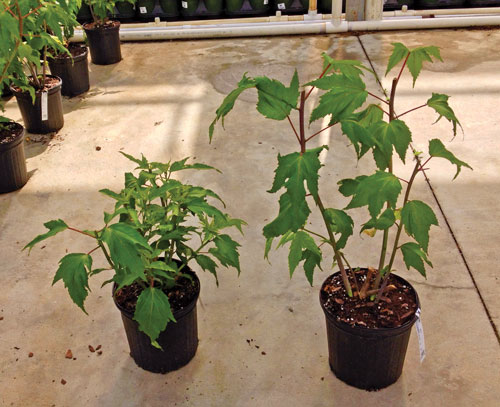4/1/2022
48 Hours
Paul Pilon
What comes to mind when you first hear “48 hours”? Is it the first-ever buddy cop action comedy film starring Eddy Murphy and Nick Nolte that debuted in 1982? Is time the first thought that jumps at you or does this phrase have some other meaning for you?
When it comes to growing, 48 hours is a rule I try to live by. Plants are living organisms and are constantly changing as they respond to the environmental conditions around them. Additionally, they’re susceptible to attacks by pathogens and pests. Growers are responsible for keeping plants healthy by managing the environmental conditions, cultural practices, and using preventative and/or curative pest and disease programs.
To address how plants respond, and to prevent future problems from rapidly advancing, I’ve learned to implement a 48-hour rule. Essentially, from the time I identify the need to implement a management strategy, I do my best to perform these activities within 48 hours. You might be asking, “Is this really necessary?” Please allow me to give you a few examples of how I’ve learned the hard way the importance of the 48-hour rule.
Why time is essential
Let’s look at plant growth regulators (PGRs) for the first example. It’s not uncommon for plants to be grown at high plant densities with other conditions that promote stem elongation. Many varieties seem to change appearances gradually over time, but under the proper growing conditions most plants actually grow and change very quickly. I’ve seen some plants easily grow at least 1 or 2 in. taller each day (some plants easily elongate more than this each day).
Each week when I walk the crops, I determine which plants would benefit from PGR applications. I’ve had times in the past when I’ve identified the need for PGRs, but for various reasons weren't able to get them applied in a timely manner. By the time they were applied, the plants had grown beyond the point where the PGR applications would’ve been helpful.
 Pictured: Here are two examples of a hibiscus cultivar. The plant on the left was pinched on time and is nicely developing lateral branches, which will result in a fuller-appearing container than the taller, thinner- looking plant on the right that was pinched too late.
Pictured: Here are two examples of a hibiscus cultivar. The plant on the left was pinched on time and is nicely developing lateral branches, which will result in a fuller-appearing container than the taller, thinner- looking plant on the right that was pinched too late.
Along these same lines, consider the consequences of not spacing crops on time. When plants are grown at high plant densities and the canopy gets established, plant quality attributes rapidly decline. When additional space is determined as necessary, it’s imperative to space the plants immediately to avoid future quality issues or problems with foliar disease below the canopy.
I’ve also seen adverse effects from not performing plant maintenance activities in a timely manner. Take pinching for example: There are times when pinching plants would be beneficial to promote lateral branching to provide fuller appearing containers. When the pinching occurs on younger, actively growing plants, the lower lateral branches release better than they do when the pinching is done on larger plants. Additionally, waiting too long may turn a pinching job to a trimming activity.
Diseases are another area where quick turnaround is highly beneficial when it comes down to management practices. Failure to act quickly with root and crown diseases can lead to more damage and may result in crop losses. Foliar diseases such as leaf spots and powdery mildew can quickly go from a few spots or colonies on a single leaf to entire leaves and plants being covered within a short period of time. Try selling plants covered with diseases!
Implement a 48-Hour rule
As you can see from these few examples, things move or progress rapidly and failure to act quickly can often mean the difference between success and failure or between making a profit or taking a loss. For these reasons, I challenge myself to accomplish various tasks and activities within 48 hours after identifying the need to take action.
The 48-hour rule has served me well and I highly encourage you to implement a similar rule or expectation once you identify the need to perform various tasks to your crops. I know it’s not always easy or practical to accomplish everything that needs to be done within 48 hours. Use this rule as a guideline rather than an absolute. There are certain items that can be prioritized to allow for slightly longer windows. For example, implementing a purely preventative program carries a lower priority than the need for curative strategies.
I anticipate that most growers intend to act quickly, but I’ve seen it all too often when I visited with growers in my previous roles that they quite often don’t religiously accomplish the necessary to-do items in a timely manner. There’s no shame in this; I’m guilty, too. However, implementing the 48-hour rule will provide you with an expectation and will help keep you on track to complete the necessary tasks to crops. Believe me, this simple rule has made a very positive impact on my ability to grow great crops. GT
Paul Pilon is editor-at-large of the Perennial Pulse e-newsletter and Director of Growing at Opel Growers in Hudsonville, Michigan. He can be reached at paul@opelgrowers.com.